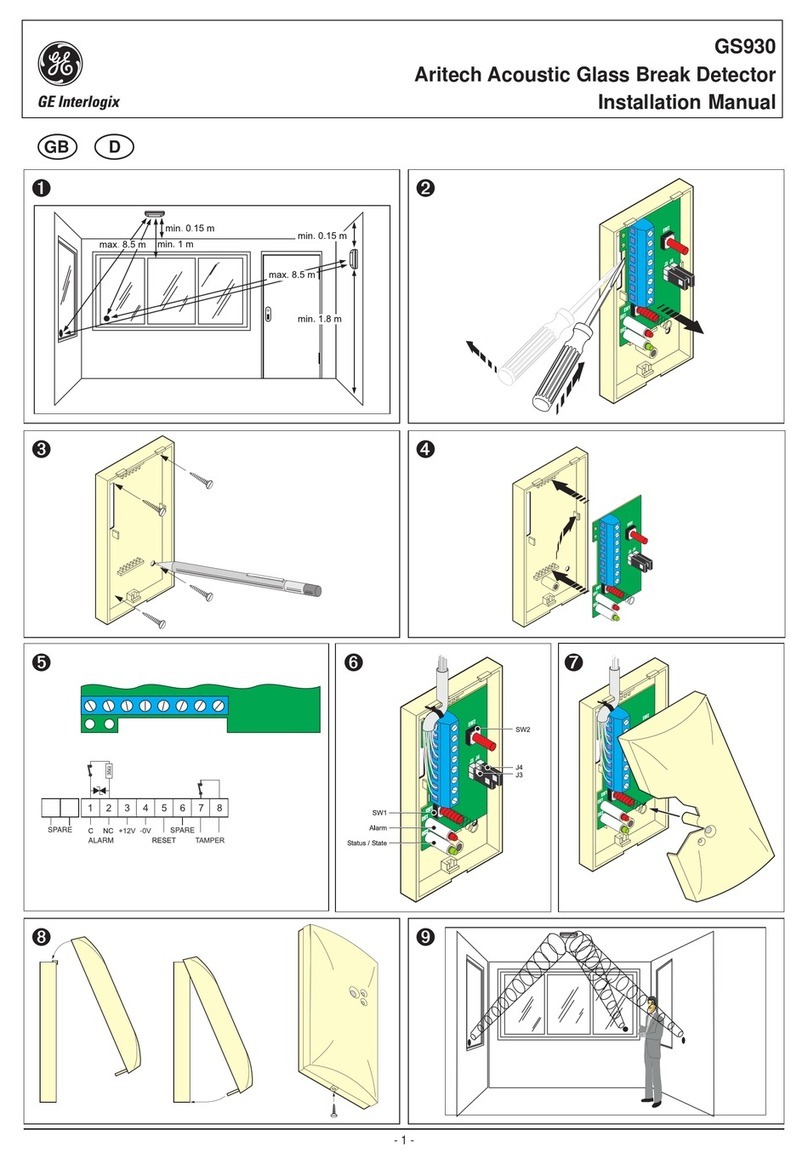
45812-RND Acoustic Glassbreak Detector
Using the Hand-Clap Test and
Alarm Memory
The alarm memory and microphone operation can be
checked with the hand-clap test as follows:
1. Standing under the detector, clap your hands together.
2. Observe the LED on the detector.
Ifthe detectorhaspowerandis functioningproperly,the
LED quickly flashes twice.
Ifthe detector has alarmed, the LED will light for 4 seconds.
Cycle the power to clear the alarm memory.
The hand-clap test is intended as a functional test, does not
open the relay, and is not an accurate indication of detector
range.
Maintaining the Detector
When installed and used properly, the detector provides
years of service with minimal maintenance.You should test
the detector annually to ensure proper operation.
Clean the cover with a damp (water) cloth as needed to keep
it free of dust and dirt. Always test the detector after
cleaning.
FCC Compliance
This device complies with Part 15 of the FCC rules.
Operation is subject to the following two conditions:
(1) This device may not cause harmful interference.
(2) This device must accept any interference received,
including interference that may cause undesired operation.
Specifications
Input voltage ........................................ 12VDCNominal
Current
Typical ................................................................ 15mA
Maximum ............................................................. 25mA
Electrical configuration ........................................FormA
Relay rating............................................. 16V,50mAmax.
Detection range .................... 5’-25’(1.5m-7.6m)x360°
(use for rooms 100 sq. ft. and larger)
Alarm response...................................................... 4 sec.
Minimum glass size............... 12”x24” (30.5cmx61cm)
Recommended glass thickness:
Plate................................ 3/32”- 1/4”(2.4mm- 6.4mm)
Tempered .........................1/8”-1/4” (3.2mm- 6.4mm)
Wired....................................................... 1/4”(6.4mm)
Laminated................................................ 1/4”(6.4mm)
Operating temperature ................. 32°- 122°F(0° -50°C)
Relative humidity ................... 10 - 90% non-condensing
Dimensions:
Depth ......................................................0.81”(2.1cm)
Diameter ..................................................4.0” (10.2 cm)
Color ..................................................................... White
Fieldwiring size ............................................ 18-24AWG
Listing ............................................................... C-ULUS
1038240 RevA 06/02
12345 SW Leveton Drive
Tualatin, OR 97062
www.interlogixsecurity.com
www.sentrol.com
© 2002 GE Interlogix, Inc.
Phone: 503-692-4052
USA & Canada: 800-547-2556
Technical Service: 800-648-7424
FaxBack: 800-483-2495
GE Interlogix
Product Ordering
Model Number Description
5812-RND Acoustic glassbreak sensor, round housing, FormA
Accessories
5709C Glassbreak hand-heldtester






















